Arcadyan recognizes the limited resources of the earth and the importance of sustainable development, and introduced the ISO 14001 Environmental Management System at its major operating locations and strictly implemented environmental management measures. In order to promote and fulfill its responsibility for environmental protection, Arcadyan formulated the "Environmental, Safety, Energy and Product Eco-design Policy" to effectively reduce the impact of business activities on the environment with the highest standards, improve environmental management performance, and achieve sustainability development purposes through continuous improvement.
Arcadyan Environmental Sustainability Policies
- Comply with the domestic environmental, health / safety, and energy regulations, and effectively implement the environmental, health / safety, and energy management system.
- All staff participate in product eco-design, environmental protection and energy
management, and promote continuous improvement for sustainability. - Improve resource recycling and energy efficiency, and reduce the impact of carbon emissions in supply chain.
- Promote training and publicity on environmental, safety and health, energy and
product eco-design. - Implement employee health management, proactively prevent occupational
disasters, and create a safe workplace with zero disasters.
TCFD Climate Change Information Disclosure
Arcadyan is concerned about global environmental changes. In order to specifically demonstrate the impact of climate change on operations, Arcadyan adopts the recommended structure issued by the Task Force on Climate-related Financial Disclosures (TCFD), including four core elements of governance, strategy, risk management, indicators and goals for explanation.
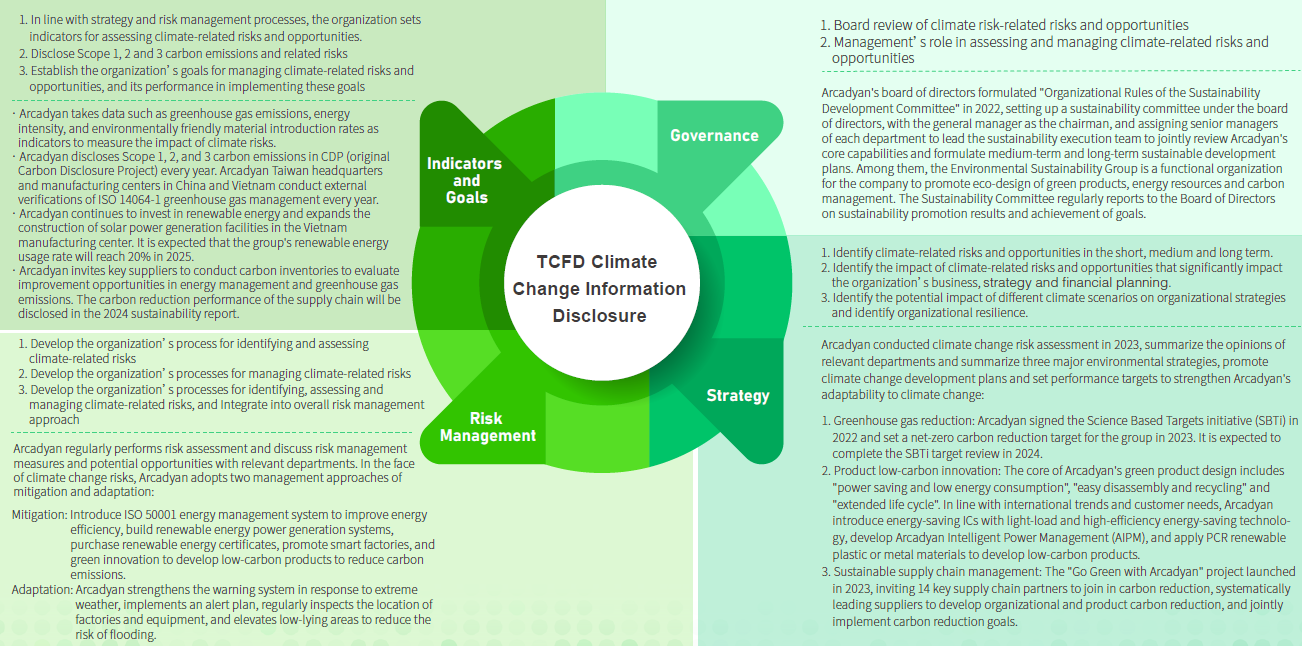
Climate Change Risk Identi cation
In 2023, Arcadyan Environmental Sustainability Team was divided into groups to collect and discuss information, identify the impact (severity) and likelihood (occurrence) of potential risks related to climate change issues, and select the 8 items with the highest risks and opportunities. The sources are "Develop low-carbon products and services (opportunities)", "Developing lowcarbon products and services (opportunities)", "Developing new technologies (opportunities)", "Diversification of business operation models (opportunities)", "Improve the efficiency of resource usage (opportunity)", "Apply recycled materials (opportunity)", "Use low-carbon energy (opportunity)", "Increase in raw material costs (risk)", and further assess its financial impact and formulate its management practices and measure.
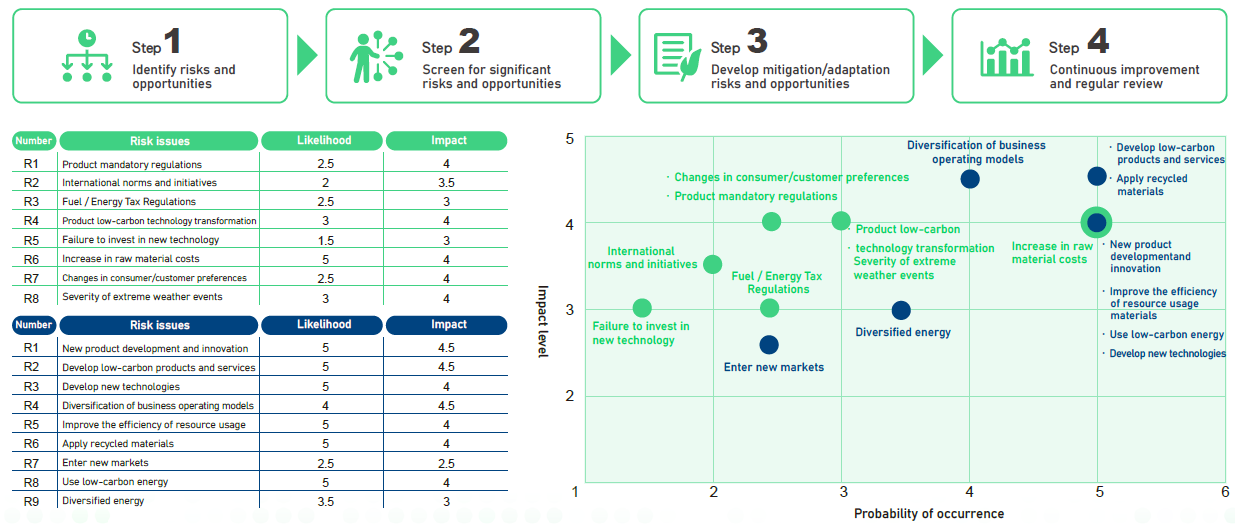
Description of risks / opportunities related to climate change and response strategies
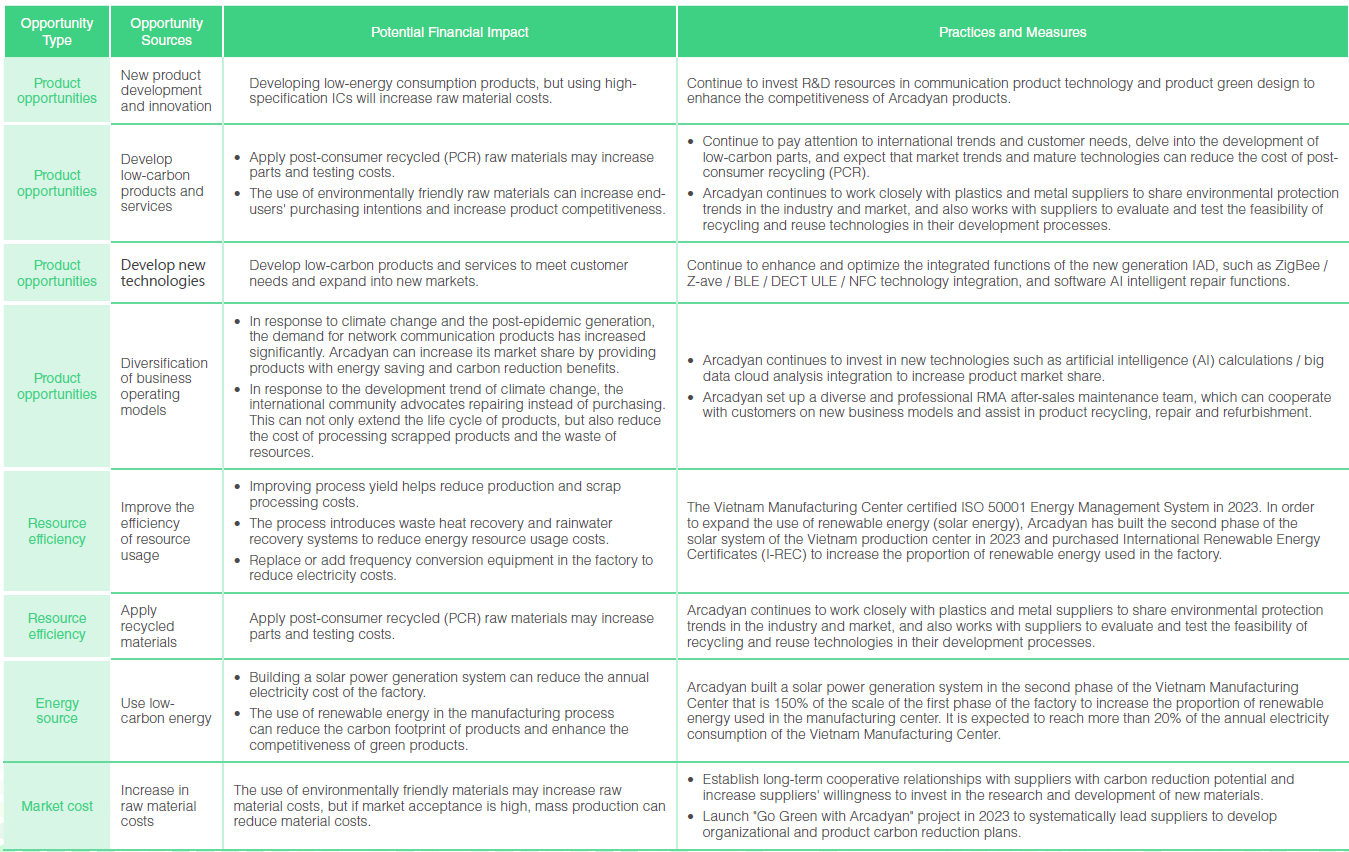
Greenhouse Gas Management
Arcadyan pays attention to the environmental issues of global climate change, including relevant agreements actively promoted by various countries, such as the Kyoto Protocol, the United Nations Framework Convention on Climate Change (NFCCC), the Paris Agreement, United Nations treaties and product energy conservation regulatory requirements. Arcadyan has participated in CDP* (original Carbon Disclosure Project) every year since 2009, proactively disclosed its own carbon performance, understood the latest climate change trends and policies, and further transformed climate change risks into green circular economy business opportunities to improve corporate business sustainability.
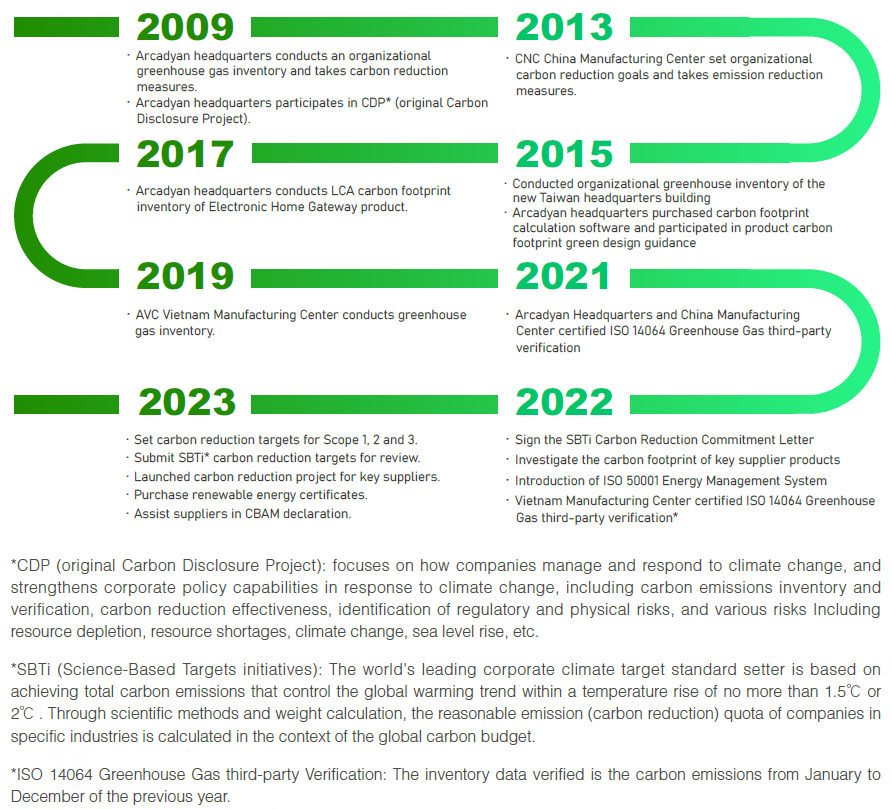
Greenhouse Gas Management Strategies and Goals
Arcadyan joined Science-Based Target Initiative (SBTi) in 2022, refer to the International Energy Agency's scenario of 1.5 ℃ warming, assess the impact of future climate change, and accordingly formulate greenhouse gas categories 1, 2 and 3 in the near-term and long-term reduction targets. In 2023, Arcadyan refer to SBTi scientific carbon reduction methodology and set more aggressive goals than the industrial carbon reduction path.
Arcadyan announced that using 2022 as the base year, set a short-term goal of reducing greenhouse gases within the organization (Scope 1+2) by 6.25% per year, with an absolute reduction of 50% by 2030, and until reaching the net-zero emission target in 2040. Arcadyan has also set a short-term goal of reducing the intensity (tons/gross profit per million) of carbon emissions from the purchase of goods and services, fuels and energy, and sales of products in the indirect greenhouse gases (Scope 3) outside the organization by 66.47% in 2030 and reach the net-zero emission target in 2050.


SBTi Net-Zero Carbon Action Blueprint and Progress Tracking
Arcdyan Vietnam Manufacturing Center obtained third-party verification of ISO 50001 Energy Management System in 2023 to improve energy efficiency. In addition to using solar power generation systems, Arcdyan also purchased 5,500 International Renewable Energy Certificates (I-REC) to offset the production electricity consumption of China manufacturing centers. The total amount of greenhouse gas categories 1 and 2 of Arcdyan is 25,035.79 t CO2e, which is about 20% lower than the total amount of 31,332.1 t CO2e in the base year of 2022, achieving the SBTi absolute reduction target of 6.25%. The carbon intensity of Scope 1 and 2 in 2023 is 0.4894 (tons/million turnover), which is 26.3% lower than the carbon intensity of 0.6643 (tons/million turnover) in 2022.
The total emissions of the three main categories of Scope 3 in 2023, "Category 1: Purchased products and services", "Category 3: Fuel and Energy-related activities, not included in Scope 1 or Scope 2" and "Category 11: Use of sold products", was 3,304,633.63 tons, and the emission intensity was 447.5 (tons/gross profit per million), which is 14.5% lower than the Scope 3 emission intensity of 523.3 (tons/gross profit per million) in 2022, achieving SBTi intensity reduced by 10.2% target.
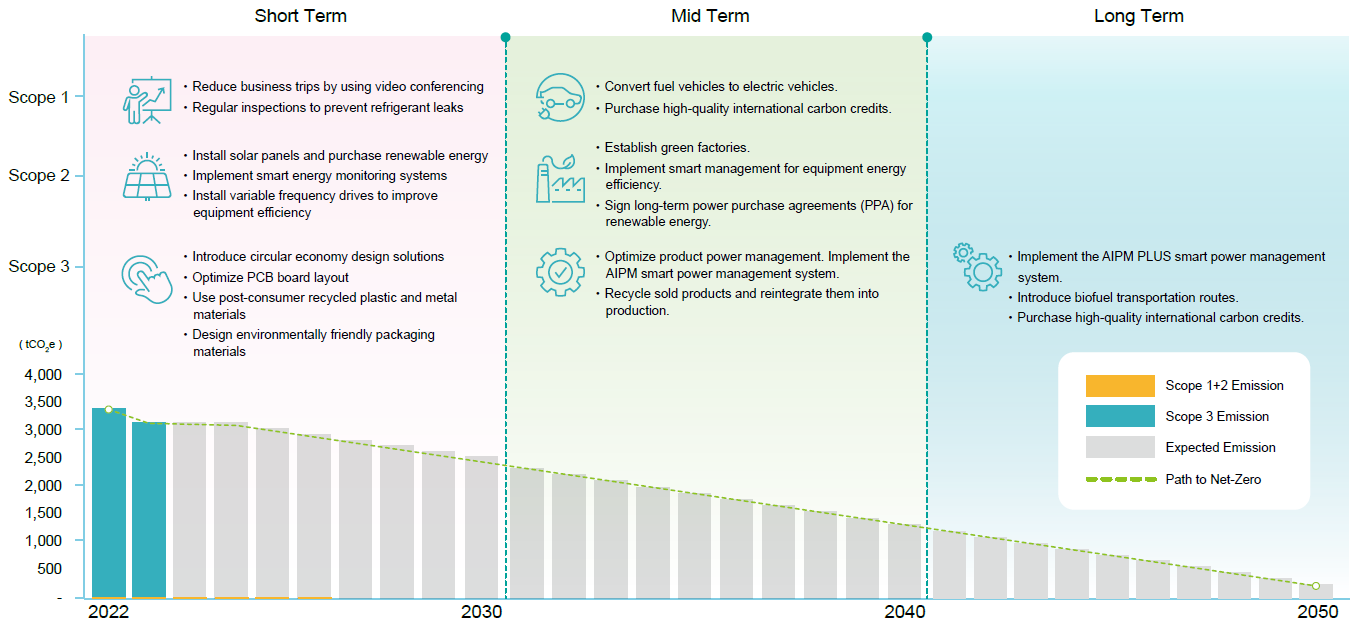
Greenhouse Gas Inventory
In 2023, Arcadyan Scope 1 and 2 greenhouse gas emissions adopted the control method in accordance with the GHG Protocol. The inventory is conducted on key operating locations, which is in line with the boundaries of Arcadyan's consolidated financial statements, and was verified by third-party in accordance with the ISO 14064-1:2018 standard.


Climate Change Mitigation and Carbon Reduction Measures
Arcadyan has formulated a comprehensive climate change response strategy that includes ISO 50001 Energy Management System certification, increasing the use of renewable energy, developing low-carbon products, implementing low-carbon transportation routes, and strengthening low-carbon supply chain management. By enhancing energy efficiency and leveraging core capabilities in low-carbon product development, Arcadyan is committed to reducing greenhouse gas emissions and mitigating the impacts of climate change.

-
Energy Transition
Arcadyan's Vietnam Manufacturing Center has installed a rooftop solar power system covering an area of 17,000m². The solar power generation was verified by SGS in 2022. In 2023, the total solar power generation at the Vietnam Manufacturing Center reached 2,527 MWH, accounting for 5.34% of the total group electricity consumption. This fell short of the 6% target set for 2022, primarily due to the increased electricity consumption from the expansion of the second plant in the second half of 2023.
It is anticipated that after the completion of the second plant at the Vietnam Manufacturing Center in 2024, the installation of the second phase of the solar system will be accelerated. Additionally, solar panels will be installed on the rooftops of the administrative building and parking lot, resulting in a combined solar area of 24,000m². It is estimated that upon the completion of the first and second phases of the solar power system, the proportion of renewable energy used by the group will increase to 20%.

The Renewable Energy 100 (RE100) is a global initiative launched jointly by The Climate Group and the Climate Disclosure Project (CDP) in 2014. This initiative invites companies worldwide to publicly commit to achieving 100% renewable energy usage.
Although Arcadyan is not classified as a high electricity consumer and does not meet the energy consumption threshold required to join the RE100 initiative, the company has consistently placed importance on energy-saving issues and is dedicated to reducing the environmental impact of its operations. In response to the international trend towards renewable energy, Arcadyan purchased 5.5 million kWh of renewable energy certificates in 2023 to actively increase the proportion of renewable energy used in its manufacturing centers and simultaneously offset greenhouse gas emissions (Market Base).
Besides purchasing renewable energy certificates, Arcadyan is actively seeking suitable renewable energy providers to evaluate the signing of Power Purchase Agreements (PPA). And plans to achieve 100% renewable energy use in production electricity by 2030, gradually realizing its strategy of energy transition and low-carbon production in daily operations.
-
Low-Carbon Commuting and Transportation
In response to the global trend towards low-carbon transportation and the encouragement to replace fuel vehicles with electric vehicles (EVs) to reduce carbon emissions, Arcadyan has established four EV-exclusive parking spaces equipped with charging stations at its headquarters parking lot. This provides the convenience of EV charging and helps reduce Scope 3 greenhouse gas emissions associated with employee commuting.
Regarding raw material transportation, Arcadyan introduced biofuel-powered transportation routes in 2023. These routes use renewable biofuels with low carbon emissions, effectively reducing carbon emissions by approximately 80% compared to traditional fuels. The use of biofuels not only helps improve air quality but also benefits climate change mitigation due to their low-carbon properties. By utilizing energy in a circular and regenerative manner, Arcadyan achieves the dual goals of environmental protection and sustainable energy use. The company will continue to focus on the development of sustainable renewable energy technologies to reduce carbon emissions throughout the value chain.